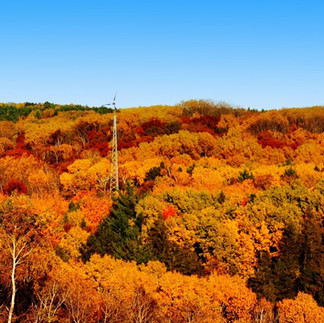Nature Notes: Fall Foliage
- HDT Team
- Sep 9, 2016
- 5 min read
Updated: Sep 30

Fall has unofficially arrived and with it has come cool evenings, dewy mornings, jeans and sweatshirts, fall harvests, pumpkin spice everything, and yes, the first leaves to change color! This month is known as Waatebagaa-giizis to the Fond du Lac Ojibwe, a name that literally means “Leaves Changing Color Moon.” The brilliant colors of autumn are one of the most beloved phenomena of the season, but do you know why the trees change colors?
First we need to understand a little about how trees function. Humans have a circulatory system that pumps nourishing blood throughout our bodies, distributing oxygen and nutrients to all our systems. Trees also have a transport system to move resources throughout their structure. Meet xylem and phloem. Xylem is a system of tubes and transport cells (vessels) that help circulate water and nutrients absorbed by the roots throughout the rest of the tree. Xylem tissue dies after a year, resulting in the annual growth rings in the trees. Phloem is the system of transport cells that is responsible for distributing the sugars/carbohydrates (food) and other molecules created by the tree itself during the process of photosynthesis. The leaves of the tree have a complete connection to the rest of the tree through these two systems.

Now, let’s talk colors. Chlorophyll is a pigment that absorbs blue and red light, but reflects green light, causing it to appear green. This light absorbing pigment is found in the chloroplasts of plant cells, where it helps absorb the energy that is required for photosynthesis. Chlorophyll is a rather unstable compound that can be broken down by bright sunlight. Since leaves need chlorophyll to make food, they are constantly producing more chlorophyll throughout the summer. There are other color pigments in the leaves as well. Xanthophylls and carotenoids are both pigments that work with chlorophyll to harvest energy from light. Xanthophylls appear yellow in color and carotenoids appear orange, however we don’t see these colors during the summer because they are masked by the chlorophyll. But now autumn is causing some changes in our trees.
At the base of each leaf, where the stem attaches to the branch, there is an area known as the abscission zone. This area acts like a bridge, connecting the leaves to the rest of the tree through the xylem and phloem, which allows nutrient laden water to enter the leaf and sugars/carbohydrates made in the leaf to spread to the rest of the tree. The autumn signals (decreasing temperature and day length) cause chemical changes in this abscission zone, resulting in the formation of two layers of cells. The first is the separation layer, which is like a corky membrane between the branch and the leaf stem. This membrane interferes with the xylem, and therefore the flow of nutrients into the leaf. This decrease in nutrients causes a decrease in chlorophyll production. The bright fall sunlight deteriorates the chlorophyll pigments that are present, causing the green color to fade from the leaf, revealing the other colors that are present – the yellows and oranges.

“Two roads diverged in a yellow wood, And sorry I could not travel both And be one traveler, long I stood” – Robert Frost
The brilliant reds are another, more complicated story. The red or purple color in the leaves is created by anthocyanins, water-soluble pigments that are dissolved in the sap inside of the cells in the leaves. Anthocyanins form from the reaction between the sugars and certain proteins in the cell sap. This reaction cannot take place until the sugar concentration in the sap is very high, which happens in the fall. When the abscission layer begins forming and starts reducing nutrient flow in and out of the leaf, water cannot get into the leaf as easily and the sugars cannot get out of the leaf as easily. This causes the sugar concentration to spike and the anthocyanins to form. These pigments are sensitive to the pH of the cell sap, so if the sap is very acidic, the pigments are bright red; if the sap is less acidic, the pigments are more of a deep purple. The formation of anthocyanin requires sunlight (as does the breakdown of chlorophyll), so it is quite common for the leaves at the edges of the trees, where they are exposed to the most sunlight, to change colors first.

In the fall, trees are trying to recover the last remaining sugars in the leaves before they drop them. Many scientists ponder the evolutionary reason plants would expend energy to produce brilliant fall colors instead of storing those sugars as food for the long months ahead. There are a few different theories as to why trees produce anthocyanins. Some believe it functions as a sort of sunscreen, protecting the remaining chlorophyll in the leaf in order to keep the dwindling ability to generate energy during this crucial period. Some believe that when leaves containing anthocyanins fall to the ground and decompose, they release something into the soil that discourages other plant species from growing. Less competition would mean the tree would have more nutrients available to it in the spring, when it needs a lot of nutrients to grow all new leaves! Others believe the formation of anthocyanins may help prevent frost injury to leaf tissues or limit water loss during autumn dry spells. Some entomologists believe they produce fall colors as a way to warn off pests! Leaves that contain a lot of red/purple color indicate a lot of anthocyanins, which a tree could only produce if it was healthy and producing a lot of food for itself. They believe the bright colors may cause certain insects that lay eggs in the fall to choose a host plant that is drab and weaker in comparison. Neat, huh?!

Whatever the reason for the production of these colors, I am grateful – the result is beautiful!
Eventually, the sunlight will deteriorate all the colorful pigments, leaving nothing but the dull brown pigment caused by tannins in the leaf. As the separation layer continues to grow, it weakens the attachment of the leaf to the branch and the leaf eventually falls off. Now, the protective second layer forms from the deposition of fatty materials where the leaf used to be, making a “leaf scar”. If you look closely at a leaf scar, you can see the “bundle scars”, which form from the xylem that carried water and nutrients to the leaf. The leaf scars and bundle scars can be used to help identify leafless trees during the winter.
The best fall colors come to us after wet summers, in falls that are warm and sunny by day, but cool (not freezing) and dry by night. Typically, the yellows will kick off with the birch and sugar maples, followed by the basswoods and aspens. We’re already seeing the red maples and sumac turning red, and later they’ll be joined by the red oaks. Did you know Minnesota has nearly 4 million acres in 50 different state forests, all of which are free to the public? Check one out this fall! You can track the color change around the state by using the MN DNR’s Fall Color Finder. So make sure you plan a weekend this fall to get outside and admire the reds and yellows blending together on Minnesota’s awe-inspiring landscapes! Enjoy!
“Fall has always been my favorite season. The time when everything bursts with its last beauty, as if nature had been saving up all year for the grand finale.” – Lauren DeStefano


















Comments